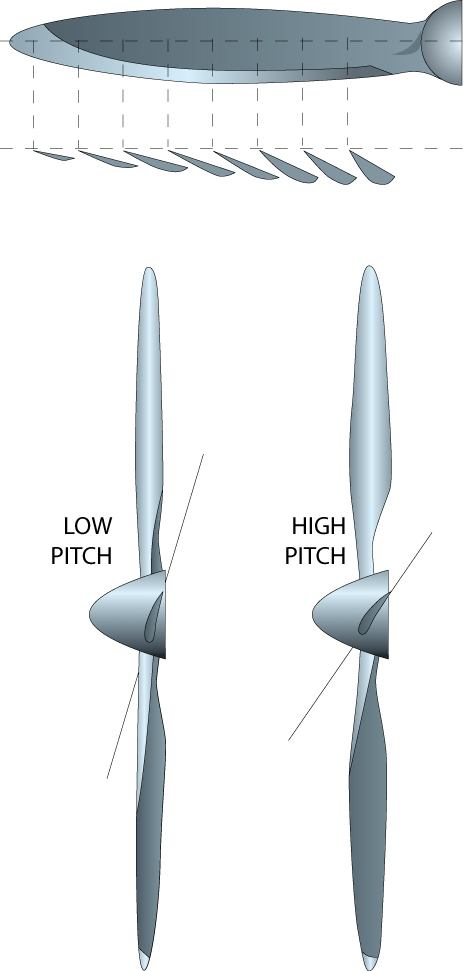Some propellers you will see on airplanes at your local airport have a fixed pitch. That means that the angle that the blade is twisted cannot be changed. The pitch of the propeller is based on the airplane and the engine. The twist varies from the hub, or base of the propeller, to the tip, and provides a constant ‘lift’ along the length of the propeller. This is because the tip travels a greater distance and at a faster speed than the hub. (See math at the end)
The length of the propeller can vary from 5 feet to 6 feet. Tommy’s weight and big radial require him to have a 9-foot propeller. The majority of piston, or reciprocating, engines have a rotation speed between 2250 and 2750 revolutions per minute (RPM) as a maximum. (See math at the end)
Tommy has a variable pitch propeller, which means his propeller’s pitch can be changed. The control for this is on the throttle quadrant, along with the throttle and mixture control inside the cockpit on the left side. This control allows Captain Billy to adjust the pitch from 11 ½ degrees to a maximum of 27 degrees.
Take a piece of paper and draw a straight line. Now take a protractor and mark a point at the 11 ½ and 27-degree mark. Draw a line from each mark to the starting point of your straight line. You can now visually see the difference. In the wing explanation, you placed your hand in the airstream and as you increased the angle you felt an increase in pressure and lift. So, as the propeller’s pitch is increased, more lift, or thrust, is generated. The high pitch, sometimes called “coarse,” is used for times such as climbing and aerobatics.

I mentioned above the difference in speed through the air. Here comes the math…
To get the airspeed of the propeller through the air you take the circumference, measured by multiplying the diameter x 3.1416, then multiplied by the revolutions per minute (RPM) x 60 minutes in an hour, then divided by the number of feet in a mile, which is 5280.
PROP MPH=DIA X 3.1416 X RPM X 60 Divided by 5280.
Let’s use Tommy’s propeller as an example:
- A 9 foot diameter x 3.1416 = 28.2744 feet
- Then take the 28.2744 feet x 2250 RPM and you get 63,617.4 feet per minute (FPM)
- Now, 60 minutes per hour x 63,617.4 FPM = 3,817,004 feet per hour (FPH)
- Finally divide 3,817,004 by 5280 feet per mile, and you get 722.925 miles per hour (MPH)
If you do the same thing to any diameter of the propeller, you will get the speed at that point. So, at 2 feet the speed will 160.65 miles per hour. Quite the difference! Therefore, the T-6 has that distinctive “growl” sound on takeoff. It is the tips approaching the speed of sound, or about 760 MPH at sea level.
Blue Skys and Tailwinds,
Captain Billy
Tommy Merchandise
Buy Tommy Merchandise such as keychains, backpacks, water bottles and stickers in our Café Press store.
Join Tommy’s Hangar
to receive special updates, exclusive illustrations, and other fun things exclusive to members!
